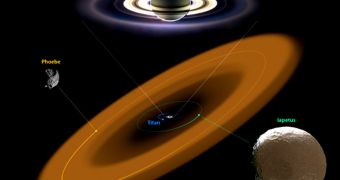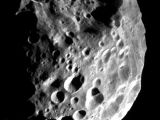The image most of us have of Saturn is that of a gas giant closely surrounded by its rings, which are very thin, yet very wide. Now, astronomers prove us wrong, showing that the planet indeed has another, massive ring around it, which extends as much as 13 million kilometers away from it, around the moon Phoebe. This is about 50 times farther out than its other rings, astronomers say. The find helps explain a long-standing mystery about the moon Iapetus, which exhibits a very peculiar trait, in that half of it is darker than the other, the BBC News reports.
In a new scientific paper, published in the latest issue of the respected journal Nature, experts from the University of Virginia, in the United States, led by Anne Verbiscer, say that the most likely “fuel source” for the new ring is the debris emanating from small impacts of the moon Phoebe, which orbits Saturn very far out into space. As collisions take their toll on the crater-filled surface of the moon, particles are spewed around it, forming the massive ring. Experts believe that the finer particles then fall towards the gas giant, striking the moon Iapetus head-on.
“It has essentially a head-on collision. The particles smack Iapetus like bugs on a windshield,” the expert explains. The walnut-shaped inner moon has a two-tone appearance, with half of it brighter than the other half. Astronomers seem to believe that fine-particle impacts are responsible for the black and gray hues that are visible on one of the body's sides.
The new ring is also very peculiar through its sheer size. While the previous outermost ring, the E Ring, orbits Saturn at about 240,000 kilometers, the newly discovered one dwarfs it by comparison. Scientists say that no such formation has ever been discovered in the solar system before. Additionally, the ring around Phoebe has a 27-degree inclination in regards to the plane on which the other rings circle the planet. The moon in its middle is also similarly inclined.
All of the material inside the ring would neatly fit inside a crater less than a kilometer in diameter. The concentrations of particles emitted by Phoebe are very low, and Verbiscer says that, “If you were standing in the ring itself, you wouldn't even know it.” She adds that, “The particles are very, very tiny, so the ring is very, very tenuous. In a cubic kilometer of space, there are all of 10-20 particles.” Phoebe is the only possible source of the ring, and, upon seeing its poke-marked surface, the conclusion is clear.

 14 DAY TRIAL //
14 DAY TRIAL // 
